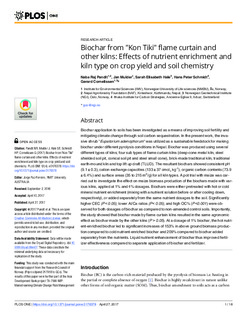| dc.description.abstract | Biochar application to soils has been investigated as a means of improving soil fertility and mitigating climate change through soil carbon sequestration. In the present work, the invasive shrub "Eupatorium adenophorum" was utilized as a sustainable feedstock for making biochar under different pyrolysis conditions in Nepal. Biochar was produced using several different types of kilns; four sub types of flame curtain kilns (deep-cone metal kiln, steel shielded soil pit, conical soil pit and steel small cone), brick-made traditional kiln, traditional earth-mound kiln and top lift up draft (TLUD). The resultant biochars showed consistent pH (9.1 ± 0.3), cation exchange capacities (133 ± 37 cmolc kg-1), organic carbon contents (73.9 ± 6.4%) and surface areas (35 to 215 m2/g) for all kiln types. A pot trial with maize was carried out to investigate the effect on maize biomass production of the biochars made with various kilns, applied at 1% and 4% dosages. Biochars were either pretreated with hot or cold mineral nutrient enrichment (mixing with a nutrient solution before or after cooling down, respectively), or added separately from the same nutrient dosages to the soil. Significantly higher CEC (P< 0.05), lower Al/Ca ratios (P< 0.05), and high OC% (P<0.001) were observed for both dosages of biochar as compared to non-amended control soils. Importantly, the study showed that biochar made by flame curtain kilns resulted in the same agronomic effect as biochar made by the other kilns (P > 0.05). At a dosage of 1% biochar, the hot nutrient-enriched biochar led to significant increases of 153% in above ground biomass production compared to cold nutrient-enriched biochar and 209% compared to biochar added separately from the nutrients. Liquid nutrient enhancement of biochar thus improved fertilizer effectiveness compared to separate application of biochar and fertilizer. | nb_NO |

